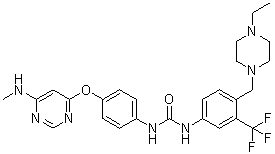| Description: |
AST 487 is a RET kinase inhibitor with IC50 of 880 nM, inhibits RET autophosphorylation and activation of downstream effectors, also inhibits Flt-3 with IC50 of 520 nM. |
| Target: |
IC50: 880 nM (RET), 170 nM (KDR), 790 nM (Flt-4), 500 nM (c-Kit), 520 nM (Flt-3), 20 nM (Abl)[1] |
| In Vivo: |
After a single oral administration of 15 mg/kg of AST 487 to OF1 mice, a mean peak plasma level (Cmax) of 0.505±0.078 μM SE is achieved after 0.5 h. Similar levels of AST 487 are found in the plasma of mice up to 6 h after oral administration, with a Clast of 21±4 nM at 24 h. The oral bioavailability is calculated to be 9.7% with a t1/2 terminal elimination of 1.5 h[1]. |
| In Vitro: |
A number of other kinases are also similarly inhibited by AST 487 (NVP-AST487) in the in vitro kinase assays, including KDR (IC50=170 nM), Flt-4 (IC50=790 nM), Flt-3 (IC50=520 nM), c-Kit (IC50=500 nM), and c-Abl (IC50=20 nM). AST 487 potently inhibits the growth of human thyroid cancer cell lines with activating mutations of RET but not of lines without RET mutations. Both GDNF/GFRα1 and persephin-induced calcitonin mRNA are markedly inhibited by coincubation with 100 nM of AST 487 in MTC-M cells[1]. AST 487 is a novel, mutant FLT3 inhibitor. AST 487 is tested in biochemical assays for inhibition of Flt-3 kinase activity. The Ki is determined to be 0.12 μM. Besides Flt-3, NVP-AST487 inhibits RET, KDR, c-Kit, and c-Abl kinase with IC50 values below 1 μM. Treatment of FLT3-ITD-Ba/F3 cells and D835Y-Ba/F3 cells with AST 487 potently inhibits cellular proliferation (IC50<5 nM). AST 487 treatment of FLT3-ITD-Ba/F3 cells with 0.01 μM AST 487 results in complete cell killing compare with approximately 50% killing of AML patient samples at the same concentration[2]. |
| Kinase Assay: |
Glutathione S-transferase (GST)-fused kinase domains are expressed in baculovirus and purified over glutathione-sepharose. Kinase activity is tested by measuring the phosphorylation of a synthetic substrate [poly(Glu, Tyr)], by purified GST-fusion kinase domains of the respective protein kinase in the presence of radiolabeled ATP; the ATP concentrations used are optimized within the Km range for the individual kinases. Briefly, each kinase is incubated under optimized buffer conditions in 20 mM of Tris-HCl (pH 7.5), 1 to 3 mM of MnCl2, 3 to 10 mM of MgCl2, 10 μM of Na3VO4, 1 mM of DTT, 0.2 μCi [33P]ATP, 1 to 8 μM of ATP, 3 to 8 μg/mL of poly(Glu/Tyr, 4:1), and 1% DMSO in a total volume of 30 μL in the presence or absence of NVP-AST487 for 10 min at ambient temperature. Reactions are terminated by adding 10 μL of 250 mM EDTA, and the reaction mixture is transferred onto an Immobilon polyvinylidene difluoride membrane. Filters are washed (0.5% H3PO4), soaked in ethanol, dried and counted in a liquid scintillation counter. IC50s for AST 487 are calculated by linear regression analysis of the percentage inhibition[1]. |
| Cell Assay: |
The trypan blue exclusion assay is used to determine proliferation of cells cultured in the presence and absence of NVP-AST 487. Cell viability is reported as percentage of control (untreated) cells, and data are presented as the average of 2 independent experiments, except where indicated. Error bars represent the standard error of the mean for each data point. Apoptosis of drug-treated cells is measured using the Annexin-V-Fluos Staining Kit. Cell-cycle analysis is performed[2]. |
| Animal Administration: |
Mice[1] Female athymic nude mice are kept under optimized hygienic conditions (maximum of 10 mice per Makrolon type III cage) with free access to food and water. Tumors are established by s.c. injection of 1×106 and 5×106 of NIH3T3-RETC634W and TT cells, respectively, in 100 μL of HBSS per mouse. Treatable tumors, i.e., mean tumor volume of 100 mm3, developed within 10 days of NIH3T3-RETC634W cell injection, and within 20 days of TT cell injection. NVP-AST487 is given p.o., once daily by gavage. The compound is formulated by dissolving the appropriate amount of powder in N-methylpyrrolidone/PEG300 (1:10 v/v). The mice are randomized into four treatment groups of eight mice each. The first three groups received daily oral administrations of NVP-AST487 at 50, 30, and 10 mg/kg, respectively, for 3 weeks. The fourth group received treatment with vehicle. Tumor growth and body weights are monitored twice weekly. Tumor volumes are determined according to the formula: length×diameter2×π/6. Tumors are collected and frozen in liquid nitrogen at the end of the efficacy study, 6 h after the last administration. |
| References: |
[1]. Akeno-Stuart N, et al. The RET Kinase Inhibitor NVP-AST487 Blocks Growth and Calcitonin Gene Expression through Distinct Mechanisms in Medullary Thyroid Cancer Cells. Cancer Res. 2007 Jul 15;67(14):6956-64.
[2]. Weisberg E, et al. Antileukemic effects of the novel, mutant FLT3 inhibitor NVP-AST487: effects on PKC412-sensitive and -resistant FLT3-expressing cells. Blood. 2008 Dec 15;112(13):5161-70. |






















